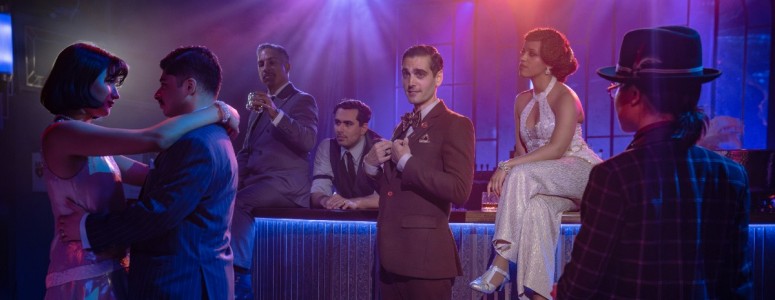You’d expect a musical of THE GREAT GATSBY to display the sound of the ‘20s – and that’s what you’ll hear right now at the Paper Mill Playhouse.
However, the ‘20s you’ll encounter in songs and dances at the State Theatre of New Jersey are the 2020s.
When you enter the lobby in Millburn, notice the historical display that mentions “The Roaring 20s and The Jazz Age.”
Then why has Jason Howland provided anachronistic music as well as orchestrations that are wrong for the time frame? So many of his songs have a backbeat that pop music wouldn’t come to know for three more decades. Drummer Skyler Fortgang must be the busiest one in current musical theater orchestras, for he’s continually boom-booming enough to rivaling boom-boxes everywhere.
Equally anachronistic is having characters who live in 1925 sing in a 2020s style. Howland has given them many a melisma – the technical term for a single syllable that stretches over two or more notes. Lyricist Nathan Tysen, one of the best of the current crop of Broadway veterans, probably was surprised to find Noah J. Ricketts as Nick Carraway not simply singing his word “Try,” but “Try-y-y.” His “So” becomes “So-oh-oh,” too.
Jeremy Jordan’s Gatsby delivers “tight” as “ty-eye-eye-ite.” Granted, he’s playing an American idol, but must he sing like the kind we’ve come to know?
Eva Noblezada’s Daisy Buchanan warbles “lost” as “law-oss-osst” before Howland in another song has her hold the final note of a song for measure after measure. This is not necessarily in Daisy’s character, but it does get applause from the audience who appreciates Noblezada’s ability to sing it for an inordinate amount of time.
This is not the way “The Roaring 20s” roared, but the Paper Mill audience screamed with delight and applauded wildly after many numbers. Michael Kunze, the German lyricist who has written many musicals (and has translated plenty of American and British ones into German) has said it best: “Today’s audiences only want to hear rock music. It doesn’t matter to them in what era a show is set. They’re not going to be happy if they don’t get the style of music that they’ve heard all their lives.”
So hances are that none of the above objections will bother most audiences. But will they balk at Dominique Kelley’s equally anachronistic choreography that has nothing in common with the 1920s.
Where’s the Charleston, the Black Bottom or the Shimmy? Yes, Kelley has created a tap number that’s right for the period. Is it a coincidence that it’s the one dance that receives the most applause?
Most of the time, though, Kelley goes for one asymmetrical herky-jerky gesture after another – back-and-forth headshakes mixed with bosom and chest thrusts. In designing all these quirky shifts, Kelley has certainly demanded a great deal from her dancers. You may well wonder how they ever learned or remembered all these illogical moves.
Howland and Kelley may rebut that other artists’ songs and dances that have replicated the 1920s have been done to death in dozens of musicals set in that time. Their aim might well be to “bring GATSBY into the 21st century.”
But to paraphrase Gertrude Stein, an anachronism is an anachronism is an anachronism. No production of CAMELOT has had King Arthur look at his wrist and tell time from his Rolex. That 1971 musical about the superstar known as Jesus Christ has never had a scene where he checks into Holiday Inn. Why should music and dance be out of period, too?
The bizarre choreography also pulls focus from Linda Cho’s exquisite costumes that enhance these party scenes. She gets with the period, as does Paul Tate dePoo III’s superb art deco set design.
He and Cho have brought back the glamour to Paper Mill. There was a time when this theater routinely spent fortunes on their musicals. That, however, was in the ‘80s and ‘90s when the organization could boast of having more than 40,000 subscribers. Paper Mill’s productions had many ornate sets that even some Broadway musicals couldn’t match.
Alas, time took its toll and tens of thousands of those subscribers went to that Great Theater in the Sky. Suddenly more modest production values were the norm.
Well, subscriptions must up – let’s hope they are for more reasons than one – for the glorious, stage-filling look has returned. With a ticket to a musical today costing an arm and a leg – and a kidney – at least here you see where your money went.
As much as dePoo has contributed to the sets, he’s done just as well with projection designs. How far technology has come in recent years, for they now look utterly lifelike. Canvas drops and wooden scenery won’t be missed as long as we have projections as dazzling as dePoo’s.
Getting this mammoth production on its feet and having it flow briskly must have been an arduous task. All the more reason to celebrate director Marc Bruni’s astonishing achievement in doing both. The time spent “teching” a show – the term that refers to getting all the sets, lights, costumes, props, sound as well as making sure that all the actors are in the right place at the right time – always takes a day or two of what is known as “Hell Week.” Considering all the splendors that speedily and sure-footedly come and go, Bruni, his assistants and staff must have endured at least a fortnight in all nine of Dante’s circles of hell.
Was the time, effort and money worth it? Some might find that F. Scott Fitzgerald’s novel that’s nearly a 100 years old is old-hat soap-opera. When you come right down to it, it’s the tired story of a husband (Tom) who’s having an affair with a married woman (Myrtle). He’s not racked with guilt, but racked with fury when he discovers that his wife (Daisy) is doing the same thing with another man (Jay Gatsby). That his cuckolder is richer and more powerful adds fuel to the fire.
Gatsby wasn’t always in the chips. As the result of questionable activities, he’s now The Man Who Has Everything – well, almost everything. He doesn’t have Daisy, the fetching young lass that he once expected to marry. Because he wasn’t then in the money, he wasn’t at the altar when she married the much-better-heeled Tom who’s now turned out to be a heel. Daisy initially believed that she made the smarter move, and to Gatsby, it still smarts.
In his favor, Gatsby isn’t the type who wants to win Daisy simply out of revenge; he truly seems to love her, and Jeremy Jordan conveys that convincingly.
By today’s standards, though, Gatsby seems immature, for he isn’t satisfied that Daisy loves him now; he also needs her to say that she never loved Tom. This might have impacted the casting of Jordan, who seems too callow to play Fitzgerald’s character who metaphorically keeps his cards close to his vest; Jordan shows us much too much up-front emotion (for which the creators share the responsibility).
The hurts pile up. “No one lives forever” sings Myrtle, and some will here too meet premature and unexpected ends that Fitzgerald envisioned. Whether or not you’ll be convinced that “Only the good die young” is another story. And for all the talk that THE GREAT GATSBY is The Great American Novel, these deaths made so many playgoers gasp out loud or even scream, which suggests that this book is not one that many have read.
There are two pistols on stage: one is a .22 caliber, while the other is of much greater caliber: Samantha Pauly as Daisy’s friend Jordan. She shoots off one sardonic quip after another, delivering each one in a dry manner commensurate with the martini she’s drinking.
Librettist Kait Kerrigan engages in some anachronisms, too. She has a character judge others on a ten-scale: “He’s a five” … “He’s a four.” That way of assessing a person’s worth came much later in the century.
She’s also not above using the vulgarism for anus. A search through Fitzgerald’s novel will show that nowhere does it include the profane word that she employs twice.
Fitzgerald spent most of the first 60 pages of his novel having his characters talk about the mysterious and elusive Jay Gatsby. Only after many a conversation and innuendo did he actually bring him into the action. All that time kept readers’ curiosity at fever pitch.
So whose idea was it to have Gatsby the first and only person we see when the curtain rises and to have him sing the first song? Why lose all that palpable suspense?
(Oh, well. At least THE GREAT GATSBY isn’t another musical set in a high school where the set contains a row of lockers, as so many have recently been the norm on both stage and screen.)
And to her credit, Kerrigan has added a powerful moment when the Buchanan’s butler enters the room where Daisy and Tom are talking to announce “There’s a phone call” which Tom rises to take – until the butler adds “for Mrs. Buchanan.” It’s a nice reminder that women just didn’t get phone calls in those days, and if they did, who was calling a wife? It certainly jump-starts Tom’s suspicions.
Still, considering the music and choreography, the creators might have been better off to actually set the story in the 2020s. True, Prohibition is long gone, but Waldheim (and Gatsby) could be dealing cocaine or other illegal substances. The art deco sets wouldn’t have to be dumped, for plenty of contemporary homes are decked out in in that style.
Yes, if this musical with its songs were genuinely brought into the 21st century, we might have had a greater GATSBY.




